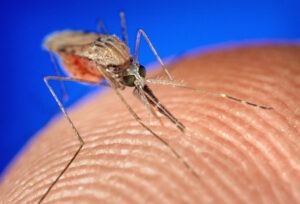Enter your address to receive notifications about new posts to your email.
Articles tagged Wildlife
(11 results)
-
Gene-drive strain of African malaria mosquito holds up against mutations
When female Anopheles mosquitoes take a blood meal from someone with malaria, a tiny Plasmodium parasite enters the mosquito’s digestive tract. That parasite can invade the mosquito’s salivary tissues, so when the insect takes another blood meal, the intruder can slip into the next human host and start a new malaria infection. Malaria is a…
-
As New Zealand’s endangered kākāpō rebounds, researchers measure genomic signs of inbreeding
Efforts to diversify an inbred population must take into account the genetic backgrounds of the founders. A female kākāpō named Rimu, whose parents are both Stewart Island founders.Photo by Jake Osborne. The nocturnal flightless parrot known as the kākāpō was once abundant throughout New Zealand. But after the introduction of mammalian predators, the species all…
-
Videos from PEQG18 Keynote and Crow Award sessions
Watch presentations from the conference, including talks from Katie Peichel and Jonathan Pritchard. Now that the dust has settled from the whirlwind of the first ever standalone GSA Population, Evolutionary, and Quantitative Genetics Conference (PEQG18), we’re delighted to be able to share the audio and synched slides from the Keynote and Crow Award sessions. We’re…
-
Venom holds clues to triggers of gene family expansion
They rattle as warning, but during the hunt their strike is silent and sudden. Any rabbit or mouse targeted by a rattlesnake is doomed—the snake’s bite carries a paralyzing venom. The toxins in this venom are proteins encoded by a large gene family that arose by gene duplication. In the July issue of GENETICS, Margres…
-
Behind the cover: Oh Canada!
February marks the launch of a crisp new look and improved navigation at the G3 website. Go check it out; we’re very proud of the design! We are also unveiling a new cover layout that allows the art submitted by our authors to shine. This month’s cover celebrates the first published genome assembly of the Canadian…
-
Fecal alchemy: Turning poop into genomics gold
When it comes to genotyping technology, poop genetics is stuck in the 1990s. While most geneticists are now awash in genome-scale data from thousands of individuals, those who depend on fecal and other non-invasively collected samples still rely on old-school, boutique panels of a dozen or so genetic markers. But feces — along with fur,…
-
First gene linked to temperature-dependent sex determination
The sex of many reptile species is set by temperature. New research reported in the journal GENETICS identifies the first gene associated with temperature-dependent sex determination in any reptile. Variation at this gene in snapping turtles contributes to geographic differences in the way sex ratio is influenced by temperature. Understanding the genetics of sex determination…
-
Kākāpō 125 Genomes Project: Sequencing an entire species
In 1996, when I started researching the conservation genetics of New Zealand’s critically endangered parrot, the kākāpō (Strigops habroptilus), little was known of the species’ genome. On many occasions after a long day in the molecular lab on the hunt for an elusive gene, I found myself imagining that I had the complete genome of…
-
Vexed: why doesn’t eastern coral snake venom vary?
When an eastern diamondback rattlesnake bites its prey, it injects a cocktail of toxic proteins and peptides that attack on multiple fronts. These toxins destroy blood vessels, block the blood clotting cascade, cause necrosis, and inflict crippling pain. But the precise recipe for this noxious mix is generally thought to depend on where the snake…
-
Bat signals: genomic traces of sensory rewiring
How does evolution rewire an animal’s sensory system? In time for both National Bat Week and Halloween, new research in G3 investigates this question by comparing the genomes of bat species that “see” the world in different ways. The black flying fox Pteropus alecto forages for fruit mainly by smell and sight. In contrast, the…
-
Frog immune responses to a global threat
Dramatic global declines in amphibians have been linked to the fungal pathogen Batrachochytrium dendrobatidis, but some species are more vulnerable than others. In the latest issue of G3: Genes|Genomes|Genetics, as part of the GSA Journals’ Genetics of Immunity collection, Ellison et al. examined the transcriptome of the highly susceptible Panama Golden Frog after exposure to…











